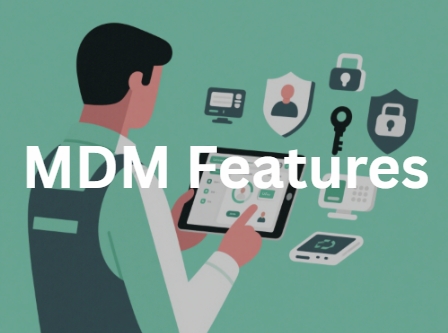MDM Features Checklist: A Feature-by-Feature Comparison
Laptops, phones and other handhelds now sit at the heart of every workflow—from curb-side deliveries to telehealth check-ins. As fleets grow, so do risks: stolen data, compliance fines and ballooning help-desk tickets. Mobile Device Management (MDM) bundles the policies, automations and dashboards that keep this sprawl safe and productive. Yet not every platform is equal; the mix of mdm features you get will decide whether roll-outs run smoothly or stall under complexity.
This guide walks you through real-world use cases, unpacks seven essential mobile device management features, compares major vendors (plus two rising alternatives) and closes with a practical selection checklist. By the end, you can map each feature to an exact business need and shortlist MDM tools with confidence.

1Why MDM Matters: Reality Checks
Industry snapshots
Healthcare: A U.S. health network uses Intune to manage provider mobile devices, which protects patient data within apps and aids HIPAA compliance efforts.
Retail: With AirDroid Business, a Malaysian retail chain pushes fresh promos to every unmanned store POS screen from one dashboard, keeping campaigns on time and looking the same everywhere.
IT Services: Managed Service Providers (MSPs) rely on role-based access dashboards to patch hundreds of client laptops before vulnerabilities hit the news.
Education: Districts lock student iPads into exam-mode and track lost devices during field trips.
Logistics: Dispatchers geofence rugged scanners so they self-wipe if they cross a border.
Deep-dive scenario—remote sales team
Imagine 500 reps scattered across time zones. In the past, each took a day to set up a fresh tablet and missed half a shift waiting for VPN keys. With MDM ensuring robust mobile device security, HR ships sealed devices; zero-touch enrollment loads the sales stack, applies a 'weekend-only' OS-update window, and tags the asset in inventory before the courier truck drives away. When a rep reports lag, support opens a real-time screen-share, pulls logs and reboots the culprit app—no hotel-lobby visits required.
2Essential MDM Capabilities Decoded
Features | Why it matters | Top performer |
|---|---|---|
| Device Enrollment & Configuration – bulk enrolling devices or zero-touch provisioning, profile assignment, Wi-Fi/VPN setup | Slashes onboarding time from hours to minutes and enforces corporate baselines on day one | Microsoft Intune integrates Android zero-touch and Windows provisioning packages in the same console |
| Application Distribution & Version Control – remote install, update, rollback, private app store | Guarantees every endpoint runs the sanctioned release, limiting crashes and CVEs | VMware Workspace ONE UEM supports staged rings and delta updates across Windows, Android and iOS |
| Security Policies & Compliance – passcode rules, mandatory encryption, geo-fencing, auto-VPN | Keeps corporates' managed devices and data secure; ensures the use of devices complies with company policies | SOTI MobiControl offers granular password/lockdown rules; healthcare orgs pair it with Intune to meet HIPAA audits |
| Remote Monitoring & Troubleshooting – live view/control, chat, file push, script execution | Resolves tickets fast, cuts travel, and minimizes downtime | AirDroid Business offers fast, easy-to-use, and stable remote control for a seamless device management experience |
| Remote Wipe & Device Tracking – GPS locate, selective or full wipe, quarantine | Limits breach fallout when hardware is lost or stolen | Cisco Meraki Systems Manager can geo-locate then wipe a device even if users attempt to factory-reset it |
| Reporting & Analytics – usage trends, security posture, cost dashboards | Informs policy tweaks and budgets; proves compliance | IBM MaaS360 ships customizable analytics on data usage, inventory and hardware health |
| Multi-Platform Integration – Android, iOS, Windows, plus directory or SSO hooks | Avoids tool sprawl and duplicate user stores | ManageEngine syncs on-prem Active Directory for seamless user provisioning across OSs |
3MDM Software: Navigating the Vendor Landscape
Established, enterprise-grade MDM platforms have been around for years, and that time on the market shows—they’re proven, stable, and reliable. They also offer a broad set of device-management tools robust enough to handle the complex demands of mid-size and large organisations.
Established Suites
Microsoft Intune Tightest Microsoft 365 tie-ins, broad OS coverage, but per-user licensing can sting small teams.
VMware Workspace ONE Deep Windows & macOS controls and rich analytics; setup complexity requires seasoned admins.
ManageEngine MDM Plus Cost-effective, on-prem or cloud, strong remote-assist; UI feels busy at scale.
IBM MaaS360 AI-powered insights and leading compliance dashboards; premium price and learning curve noted by SMBs.
Pain points of traditional MDM
Gartner and industry surveys cite three chronic issues: high licensing + training costs, console complexity, and scarce IT headcount—problems that hit mid-market firms hardest.
Rising Alternatives
AirDroid Business – An Android-focused MDM with per-device pricing. It handles unattended or field devices well, thanks to kiosk mode, remote camera control, application management, and location tracking.
SureMDM by 42Gears – SureMDM manages Android, iOS, Windows, Linux, macOS, VR, and IoT devices in one console. It also offers BitLocker control for Windows security and secure file transfers.
Quick Selection Checklist
- Headcount & Skills – How many admins will own the console?
- Regulatory Weight – HIPAA/PCI? Look for audit trails and encryption toggles.
- Device Mix – Android-only fleets might skip pricey iOS modules.
- Budget Model – Per-user vs. per-device vs. perpetual licence.
- Growth Horizon – Can the tool automate new-hire staging and self-service?
- Basic Security Tools – Can it remote wipe, enforce passwords?
- Deployment Model – Where will the MDM software run?
- User Experience – Is there a user-friendly self-service portal for common tasks?
4Implementation Considerations
Security vs. Privacy
BYOD programs collapse without trust. Ensure robust data security by separating work/personal data through OS - level containers and publishing a policy stating exactly what IT can see (apps, not photos). Over half of organizations that ban BYOD still observe shadow usage, underscoring the need for transparent controls.
Taming IT Workload
Automated profiles and scheduled updates shave hours off set-ups; choosing a console with guided wizards can relieve overstretched staff. Device-as-a-Service partners or MDM-as-a-Service models offer another escape hatch for lean teams.
Conclusion
Mobile fleets keep growing, and every extra device widens the attack surface. Learn the core mdm features—enrollment, app control, security, analytics—and choose a tool that matches your risk, not the loudest sales pitch. If Android and Windows rule your stack and you need a simple console, try AirDroid Business. Share this guide with the team and spark the discussion.
FAQs







Leave a Reply.